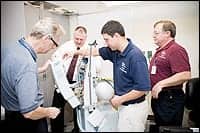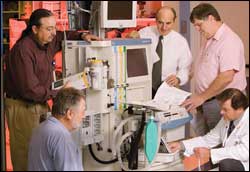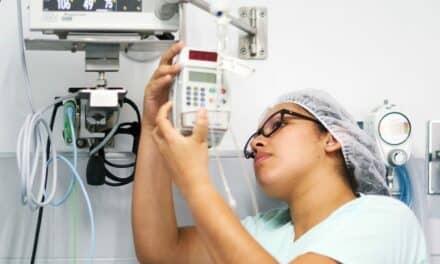 |
| L-R: Uffe Schlein; Greg Mika, clinical engineering manager; Ashley Kindig; and Brian Weidman, CBET, test a ventilator in the clinical engineering shop. |
Established more than 100 years ago, Martha Jefferson Hospital, Charlottesville, Va, recently decided it was time to move to a more spacious, modernized facility. So the administration found one—about 3 miles down the road. It is a short distance, but still a big job.
The 360,000-square-foot hospital holds 176 licensed beds and, in 2006, recorded in-patient admissions at 9,377. More than 117,000 outpatient visits were handled, and more than 32,664 emergency patients were cared for. There were 1,700 births, 2,096 inpatient surgeries, and 4,535 outpatient surgeries. Services include cancer care, digestive care, cardiology care, and women’s health centers; orthopedics, including spine and joint replacement surgeries; thoracic surgery; and vascular medicine and surgery.
Naturally, equipment ranges from the simple to the very complex. The diagnostics and medical imaging centers feature three MRI instruments, three CT scanners, and PET/CT. Cardiovascular technology offers interventional cardiac catheterization, electrophysiology, interventional radiology, and a certified vascular ultrasound lab. Altogether, there are more than 5,000 devices (5,011 to be exact) throughout the system’s hospital, outpatient care center, and nine clinics.
This inventory is expected to expand with the move. Even though the number of patient beds will remain the same, the number of rooms will increase and the new hospital will feature all private rooms.
“Certainly, the inventory is going to grow quite a bit,” says Greg Mika, clinical engineering manager at Martha Jefferson Hospital, and president of the Virginia Biomedical Association. Providing an example, he notes the move will more than double the number of vital signs monitoring systems.
However, the clinical engineering team expects to continue to service and maintain a large portion of this inventory. Examples of devices currently handled in-house include anesthesia equipment, cath and electrophysiology lab equipment, patient beds, patient monitoring systems, patient televisions, sterilization equipment, ultrasound machines, and ventilators. The team does not handle radiology systems, but closely monitors the service contracts for CT, MRI, x-ray, and linear accelerator equipment, which adds to an already busy workload.
In 2008, the five-person department—one supervisor, three technicians, and an administrative team member—closed 4,869 work orders, each with high service requirements. The department’s goal is to achieve excellence, meaning: 100% customer satisfaction, interpreted as good communication and fast turnaround; a 100% completion rate on all of its preventive maintenance (PM); and a complete commitment to improving patient care. To obtain and maintain these high aims, the team stays busy, works smartly, and strives never to say, “It’s not my job.”
With Team Effort
 |
| L-R: Manager Greg Mika and technicians Uffe Schlein and Brian Weidman check the Witt monitoring system in the interventional radiology area while clinical engineering technician Ashley Kindig looks on from the procedure room. |
A major key to the success of the Martha Jefferson Hospital clinical engineering group is its teamwork. “I’ve got a great team of technicians that are capable of running their day-to-day operations on their own and only report to me by exception,” Mika says.
To give individual team members time to complete PMs or other routine responsibilities, all incoming service requests are sent to one point person throughout the day. That technician handles the first look on any service call. If he discovers that he needs another set of hands or a colleague with more experience, then he will involve another team member. Otherwise, the two clinical engineers not “on-call” are free to complete their tasks. The system works well, but is not without difficulties in a hospital that embraces “doing more with less.”
“The real challenge comes when somebody is out sick or taking a day off, and there are only two technicians left. That puts pressure on things,” says Uffe Schlein, a clinical engineering technician at Martha Jefferson Hospital.
It may also get tight when a repair or project takes longer than expected—say, 2 days.
“The other two people really have to hustle and make up the time,” says Brian Weidman, CBET, another clinical engineering technician at the hospital.
Flexibility is also key. “Many times, we’ll come in and do PMs on the weekends or after hours,” says Ashley Kindig, clinical engineering technician. This makes the process easier on the biomed and the department that uses the equipment.
A busy area, such as the operating room or emergency department, can benefit from service during off hours. In some cases, overtime is paid; in others, a comp day is rewarded. Occasionally, the vendor is called in.
“Sometimes, we have no choice,” Mika says. “If someone is on vacation for a week and a piece of equipment goes down, it can be a little too much. Then we end up calling the vendors in—but we try not to do that.”
Instead, the clinical engineering department has expanded the team through participation in the Virginia Alliance, a regional sourcing collaborative. One work group is exploring whether areas of medical equipment maintenance sharing among member hospitals would increase effectiveness and efficiency. Additionally, Mika’s role with the Virginia Biomedical Association brings further opportunity for information sharing and the exchange of best practices.
By Deciding What’s In, What’s Out
If a device can be serviced and maintained in-house, the clinical engineering team at Martha Jefferson would rather keep it in-house, but there are limitations to what the team can do. When deciding to what extent the department should service a particular type of equipment, a team assesses the device for service needs.
Clinical engineering manages a service agreement analysis team, a multidisciplinary group of hospital staff that reviews and validates the need for all service agreement initiatives and renewals. The team considers what training is available, how labor intensive the service will be, and how many pieces of the instrument will be acquired. A one- to two-piece order may not justify the associated training, service, and maintenance costs.
“If we’ve got the biomed training, we try to send somebody and then determine afterward if it is something we have the time, ability, and quantity to take on,” Mika says.
One factor considered is how much time service, troubleshooting, and repair can take. “There is a saturation point,” Weidman says, noting the team is rapidly approaching a period where it won’t be able to take on additional large systems that require a lot of time because of the impact on service quality. “It’s hard for us to be able to [offer the maintenance] in a way that we’re happy with the service we can provide to the customers,” Weidman says.
Mika adds that a saturation point can also be applied to the amount of training and workload for which an individual team member can assume responsibility. “You can only send someone to so much training before it starts to become system overload on the human brain,” Mika says.
By Giving 100 Percent
 |
| L-R: The team at work—Greg Mika and Ashley Kindig, foreground, and Uffe Schlein and Brian Weidman. |
Fortunately, the Martha Jefferson clinical engineering team has not hit that saturation point quite yet and continues to set high standards for its performance. The effort is supported by a hospitalwide bonus program referred to as “Shared Excellence.” Monetary rewards are given to staff if the hospital meets stated objectives, as well as to individuals within groups that achieve departmental goals.
In setting its objectives, the clinical engineering team decided to aim for a 100% PM completion rate. Many facilities adjust their goals a little lower to allow for some error.
“When you beat [a PM completion goal of] 95%, there is potentially 5% that didn’t get addressed. What happens to those PMs?” Mika asks.
To eliminate this question, all PMs due at Martha Jefferson must be completed within 2 months. In those instances where an item cannot be found—”no matter how hard we look,” Weidman says—the PM is closed, noted as not found, and the equipment is removed from service. “This way we don’t have an ever-expanding list of equipment we can’t find. And if the equipment turns up later, we’ll test it and return it to the inventory,” Weidman says.
This keeps the team prepped for inspections. “If Joint Commission comes in, we have very few stickers that are expired because we make sure to go back and service them,” Mika says.
The clinical engineering department has its own benchmarks it uses to monitor performance. “We do an annual survey that highlights where we are struggling and where our department is excelling,” Kindig says. The information is collected by an outside firm to remove bias and ensure objectivity.
By Saving Money Creatively
Nothing is quite as objective, or influential, with administration as numbers, so the clinical engineering team at Martha Jefferson also includes cost-saving efforts in its goals. A major initiative focuses on parts. When a part is needed, the technicians will spend a little time looking for alternate vendors and comparing costs rather then buying the item from the first vendor found. In some instances, such as when a bracket was needed to add flat-screen monitors to a boom in the cath lab, the team has even been able to manufacture the part itself. “The doctors were thrilled with the bracket,” Mika says.
Even more thrilling have been the results. In 2009, the first year in which these financials were tracked, the team reported a savings of $81,000, an amount significantly above the $20,000 that had been projected. “Some of that is due to a one-time or first-time savings that we will not be able to report next year, but it was still a much larger savings than we expected,” Mika says.
Still not sure what to expect in year 2 (the fragile economy does not help in this regard), the team has projected that it will be able to save another $20,000 this year, though Mika thinks the actual savings might rise higher.
As with the brackets, the team uses its creativity to reach its goal. In another example, unused roll carts in the inventory were modified to fit equipment from another manufacturer, saving $400 to $500 on each item.
Where possible, the team will bring equipment service and maintenance in-house, which lowers contract pricing; when outside help is needed, the team will evaluate third parties. Referring to transmitters, Weidman notes they have been able to find a third-party vendor for repairs at one-third to one-fourth the cost the manufacturer charges ($800 versus $3,000 to $3,200).
“We want a good price, but we also want good quality,” Weidman says. “We do keep track of [any third-party repair] to make sure it was actually done properly.”
Similarly, the savings may not always be worth the time spent searching. “If you’re only going to save a couple hundred dollars, it’s not worth the time,” Weidman says. “But, if you’re going to save two or three thousand dollars, that’s worth a little bit of effort.”
By Guiding Acquisitions
The clinical engineering team also makes an effort regarding the acquisition of hospital devices, not just parts. With the move, this effort has grown. The new hospital will feature a mix of existing equipment and new acquisitions. For instance, one cath lab will be moved and another purchased.
The biomed department must sign off on all capital purchases, and it has the responsibility of guiding the clinicians in their decisions, a system that was established long before the move. The team uses information from the clinical equipment maintenance system to help determine which technologies may be more cost-effective. Relevant data answers questions regarding how much an existing device costs to maintain and whether it is worth spending more money. “Or, is there a different technology that might be more cost effective?” Weidman asks.
The biomed team will try to suggest equipment that integrates well with other systems in the hospital. “We’re really trying to preach standardization so equipment can be more efficiently used,” Weidman says.
Weidman notes that clinical engineering’s opinions carry different weight depending on the audience. “Some people/departments are much more willing to listen to what we recommend than others. If we have a lot to do with a department, they’re much more likely to give our opinions real weight,” he says.
The key is communication. “We’re not clinicians, but we have a practical point of view,” Weidman says. “At the same time, they can explain why a certain piece of equipment might work better for them. So it helps educate both ways.”
Through Testing, Testing, and More Testing
Until the new hospital site was purchased, the clinical engineering team at Martha Jefferson did not have to spend significant time on construction or renovation projects. In the past 6 years, only two projects were undertaken: a remodeling of the lab and renovation in the emergency department. Now, however, the biomeds are responsible for an increased number of capital acquisition sign-offs, equipment trials and testing, installations, and deinstallations, along with their routine responsibilities.
“We’ve seen a lot of equipment coming in for trials, which creates a lot of work, whether it be an install, deinstall, or just keeping track of equipment on the floors,” Kindig says. The goal is to select the most appropriate equipment (the administration lists clinical value above cost in its criteria) for use throughout the hospital, from large, complex systems to simple instruments.
The team recently tested lights for use in the new operating rooms before making a purchase, narrowing the selection from five vendors to one. The vendors were first approached by Mika, who asked if they would be willing to come on-site with a portable light to evaluate. The OR staff then voted for their preferences, and the top three vendors were asked to provide demo lights for a 2-week trial.
“We try to give all the venders the same amount of trial time so they are on even playing fields and the best product for our hospital is chosen,” Kindig says. From the demos, a light was selected and negotiations began. Uncooperative vendors are excluded, though Mika notes that no company has refused to provide a trial.
To keep track of the equipment, the biomeds log it in and check it before it is delivered to the appropriate floor. Database information includes the sales representative’s name and number, the expected trial time, and the in-house location. “We put our sticker of approval on the equipment along with a label that states trial equipment,” Kindig says. “This helps us to find the equipment when it needs to be sent back to the vendor. It also informs the users that we are evaluating this equipment, which helps to get more input from them.”
The larger-scale equipment has required quite a bit of extra work, particularly with installations and deinstallations, and the team has put in some overtime. Yet, they feel it is worth the effort. “The trial process has indeed caused us lots of extra work. However, choosing the best product will hopefully save us time and headaches in the long run,” Kindig says.
With a Little Help
Completion of the new facility is slated for late summer of 2011, and the biomed workload is likely to increase as that point nears. Currently, Mika is able to devote a significant portion of his time to the new site because Kindig, Schlein, and Weidman handle the rest.
“It is going to become a challenge, though, when it comes time to actually bring the equipment in, run safety checks, tag the devices, and enter the information into our database,” Mika says.
To determine whether the team should expand, the hospital has hired a consultant to evaluate current and future demand. The process started with identifying the top 10 devices requiring the most biomed time throughout the year. “The consultant is looking at how many devices that currently is, how many devices there will be in the new hospital, and determining the increase,” Mika says.
He expects the consultant will recommend a new hire for the new hospital and would like to see a technician brought on for the transition. “Is it going to be cost effective to bring in another biomed?” Mika asks. Probably.
It is a big job for a small team, and even with another hire, they will be only six. But by staying busy, working smartly, and never passing the buck, they earn big respect, big responsibility, and even a bit of a bonus.
Renee Diiulio is a contributing writer for 24×7. For more information, contact .




